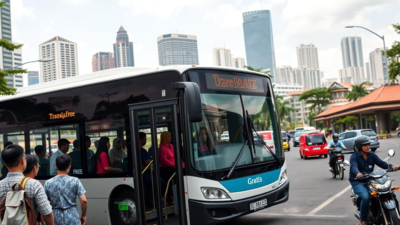
Representative Image (AI)
Scattered among the ever-moving traffic of Indonesia's capital, Jakarta, are a couple of thousand blue and white minibuses. They travel to every corner of the city, carrying an endless stream of people who hop on and off without having to worry about the hassle of parking.The network is a vital part of this 11-million-strong megacity's answer to a big problem. Too much motorized traffic.Jakarta is not alone. Globally, air pollution and road accidents caused by cars, vans and motorbikes kill around two million people each year, and combustion engine vehicles account for around 10% of the global carbon emissions causing climate change.For decades, the response to a growth in traffic has been to build more lanes, flyovers and parking.
But this only attracts more cars and greater potential for congestion. Now in a bid to for safer, decongested roads and cleaner air, some cities and countries are trying to get their citizens to ditch cars in favor of public transport. Their approaches are as varied as the results.
How enticing is free public transport?
Some cities, such as the Estonian capital Tallinn, have opted for a seemingly simple solution. In a 2012 referendum, residents of the almost half a million-strong city voted to make trains, trams and buses free for locals.
Since 2013, the cost of public transport has fallen to the city government, to the tune of around €40 ($45) per person annually — with mixed results, according to Merlin Rehema, a sustainable city researcher with the nonprofit research group, Stockholm Environment Institute."Ridership has fallen dramatically, from 42% to now like 30%," Rehema said, adding that car use has gone up by about 5%. "People who were using public transport anyways, are now using it more often.
And to some extent, short walks and bicycle trips that were taken before also became bus trips."Other places — such as Luxembourg, the island of Malta and the US city of Kansas City — that have also made their public transportation fare-free, report similar outcomes. Researchers attribute this in part to Covid-era restrictions, but that is not all that's at play.
For the love of the automobile
Pete Dyson, a behavioral scientist at the UK's Bath University, says decisions around how people choose to travel also come down to psychology. "When people look at the psychological aspects of car ownership, they typically look at areas of status and of pride," Dyson said, adding that cars also meet a fundamental human need for safety and comfort in a way that delayed and crowded buses do not.He adds that this need can be addressed by giving buses priority over cars to make journeys smoother, punctual, and more reliable. And by making public transport "a safer environment, a more comfortable environment." Ensuring other benefits like "access to a seat or a table, or the ability to do useful or meaningful things while travelling," would help too.
Riding the bus with TransJakarta
That's the way things are moving in Jakarta. Buses are air-conditioned, have a separate seating area for women, and staff are on hand for any assistance and information required. Buses painted pink are women-only. Each trip costs the equivalent of €0.20. Around 10% of trips in the city are currently made by bus and train, a number the government wants to increase that number sixfold by 2030.
But car and motorcycle traffic are growing."The major challenge here, or the major homework here, is to push people to use public transport," said Gonggomtua Sitanggang, the Southeast Asia Director of the non-profit Institute for Transportation and Development Policy. So far, Jakarta has established what is known as a Bus Rapid Transit (BRT) system, which repurposed existing lanes to create 14 bus-only corridors.
The TransJarkarta network, as it is called, covers 250 kilometers or 155 miles and is connected to the 2,200 blue and white minibuses that can be caught within 500 meters of most places across the city. "And these minibuses are free of charge to incentivize people to use public transport," said Sitanggang, adding that this kind of first and last-mile connectivity is important to create access to public transport.
Discouraging car ownership
Some cities are taking a different approach and are trying to make driving less appealing, such as through levies.
From this year, car owners in Estonia will have to pay both an initial registration fee and an annual vehicle tax.Meanwhile, London established a congestion charge zone that saw car traffic fall and bus and tube usage go up.But Merlin Rehema says there are other ways to disincentivize driving, such as "really redesigning your cities in order to favor public transport use."This is what Paris has been doing by removing tens of thousands of parking lots, closing entire roads to cars and tripling parking fees for big and polluting SUVs.Jakarta is also starting to redesign infrastructure in the central zone of Dukuh Atas, which has tens of thousands of parking spaces but also sits at a major public transport hub with bus and rail connections."We start by improving the connectivity, the pedestrian and cycling facilities, and then we develop a strategy of how to reduce the parking space within the area," said Sitanggang.Even cities that cannot quickly transform infrastructure can take action, Dyson said. "Some quick fixes to an existing network would be improving the quality of information about routes and wayfinding and making tickets and fares simpler."

 3 hours ago
35
3 hours ago
35




























 English (US)
English (US)